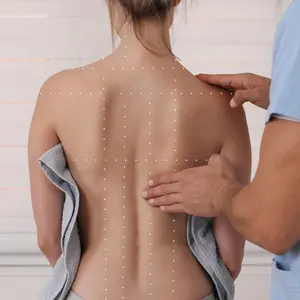

Integrative Health and Wellness

Integrative Health and Wellness
Back-To-School: Backpack Safety Tips To Avoid Injury
“As the twig is bent, so grows the tree.” Backpack misuse can lead to back pain and lifelong problems. With school starting for millions of children this week, Dr. Andy Smith, a Pediatric Doctor of Chiropractic, gives helpful tips for parents on how their children can avoid injury and pain.
A quick Google search will show 5,000 to 7,000 backpack injuries requiring emergency room visits in the United States each year. This includes children’s injuries to the head, face, hands, wrists, elbows, shoulders, feet, ankles, and spine. The mechanisms of these childhood backpack injuries include tripping, getting hit by another child’s backpack, and—probably the easiest to avoid—simply wearing the backpack incorrectly.
Combine this information with statistics showing one-third of children 10-18 years old suffer and require treatment for back pain—with the incidence rising as age and weight increase—and the need to prevent backpack-related injuries whenever possible is clear. It is much easier to prevent a problem than treat it.
It’s critical to buy a backpack that is appropriate in size and function.
Clinically, we see that the most obvious factors contributing to these injuries are backpacks that are too long, too heavy, or incorrectly worn by the child. Correcting the underlying cause of improper backpack use, as well as any injury that has been caused to the spine and body, appears to facilitate symptom relief, hopefully also avoiding long-term degeneration from years of repetitive injury.
Choosing and Wearing a Properly Fitting Backpack
A review of multiple scientific studies indicates that carrying a backpack weighing in excess of 10% of body weight can create significant pain, adversely and seriously change posture and gait, create balance issues, increase falls, and even affect breathing function. So, it’s critical to buy a backpack that is appropriate in size and function.
Carrying a backpack weighing in excess of 10% of bodyweight can create significant pain.
The width of the backpack should match the outside ridge of the shoulder blades. The top of the backpack should be at the top of the shoulders. The bottom of the backpack can reach the waist line or up to two inches below the waist as children grow older and taller, but it should never extend below the hip line.
(Source: ThoughtCo.com)
Kids who wear their backpacks over just one shoulder usually lean to the other side to offset the extra weight. They often shift their hips to further compensate for the uneven weight. Wearing a backpack on one shoulder creates the same problems as only exercising half your body. This causes pain, eventual dysfunction, and possible balance issues and falls, so the backpack needs to be worn in the midline of the back. Extra care must be taken to avoid these same issues if a courier-style backpack is used.
Using two backpacks may be an option, with a larger and necessarily heavier backpack used to and from school, and a smaller, lighter bag used between classes and for trips to the locker.
Suggestions:
- Make sure your child’s fully loaded backpack weighs no more than 10% of their bodyweight.
- The backpack should never hang more than two inches below the waist line. A backpack that hangs too low increases the weight on the shoulders. This causes your child to lean forward, creating neck, middle back, and lower-back injuries, including headache and other pain, as well as loss of function. This bad posture may also exacerbate other health issues.
- A backpack with individualized compartments may help in positioning the contents most effectively for weight and balance.
- Bigger is not necessarily better. Even if your child is tall enough for a larger bag, the more room there is in a backpack, the more your child may carry and the heavier the backpack will be.
- Urge your child to use both shoulder straps to balance the weight.
- Wide, padded straps can be very helpful in avoiding pain, irritation, and bad posture.
- Non-padded straps can cause the child to lean forward or to the side to avoid pain, creating a scenario of long-term repetitive-motion injuries.
- The shoulder straps should be adjusted so that the top of the backpack is at the level of the top of the shoulders to avoid increasing the load on the lower spine, causing the child to compensate by holding their head forward.
- If the backpack is just too heavy, ask the teacher if your child can leave the heaviest books at school, have an old copy of a heavy book to keep at home, or bring home only light hand-out materials. The teacher may require a note for this accommodation, which your chiropractor or pediatrician may provide.
- “Roller-packs”—essentially backpacks on wheels—may be helpful if all classes are on one floor but can be difficult to carry up and down stairs. Other downsides are they may not fit in lockers and can lead to falls if left to clutter hallways. While roller-packs are sometimes the perfect intervention, especially on college campuses where the buildings can be quite a distance apart, the layout of the school’s hallways and staircases as well as the location of the bus are important considerations before deciding on this option.
Dr. Andy Smith is a New Jersey-based chiropractor specializing in back and neck pain, sensory processing disorder, and pediatric services.
REFERENCES
Perrone, M., Orr, R., Hing, W., Milne, N., & Pope, R. (2018, November 12). The impact of backpack loads on school children: A critical narrative review. International Journal of Environmental Research and Public Health, 15(11): 2529. https://pubmed.ncbi.nlm.nih.gov/30424517/
Salamon, M. (2019, March 12). One-third of US kids have back pain, study says. HealthDay News. https://www.webmd.com/children/news/20190312/one-third-of-us-kids-have-back-pain-study-says
Wiersema, B. M., Wall, E. J., & Foad, S. L. (2003, January). Acute backpack injuries in children. Pediatrics, 111(1): 163–166. https://doi.org/10.1542/peds.111.1.163


 By
By






